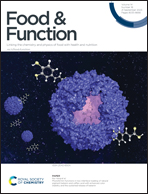Characterization and biological function analysis of endogenous peptides derived from donkey colostrum proteins†
Abstract
Donkey colostrum, due to its abundance of active ingredients, including lysozyme, proteins, and peptides, is essential for the growth and immune defence of newborns. However, research on endogenous peptides in donkey colostrum is inadequate. This study analysed the profiles of endogenous peptides, their potential bioactivity, and the enzymes that generated these peptides using two different strategies. A total of 6202 endogenous peptides were characterised through a database search, while an additional 2997 peptides were identified de novo. Among the 1142 proteins identified, trypsin and plasmin demonstrated the highest bioactivities. Furthermore, a bioinformatics-based screening identified antioxidant peptides, angiotensin I-converting enzyme inhibitory peptides, and dipeptidyl peptidase IV inhibitory peptides as the three most active peptides. Gene Ontology (GO) annotation and Kyoto Encyclopedia of Genes and Genomes (KEGG) pathway analyses were conducted. These findings enhance our knowledge of endogenous peptides in donkey colostrum and provide crucial information regarding these peptides as nutritional factors for the future development of functional foods derived from donkey sources.



 Please wait while we load your content...
Please wait while we load your content...